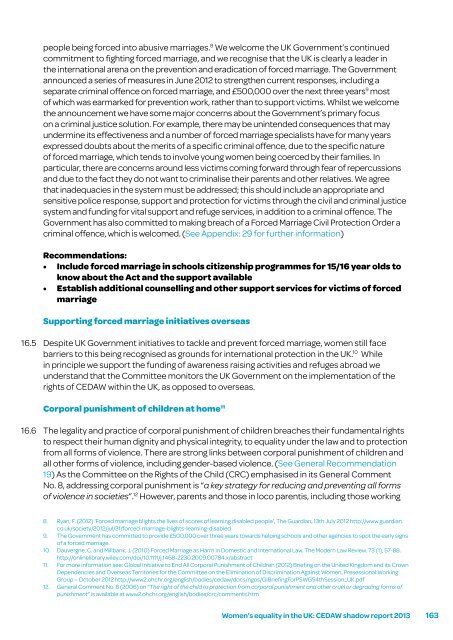Women’s equality in the UK – A health check
Women’s equality in the UK – A health check
Women’s equality in the UK – A health check
Create successful ePaper yourself
Turn your PDF publications into a flip-book with our unique Google optimized e-Paper software.
16.5<br />
16.6<br />
people be<strong>in</strong>g forced <strong>in</strong>to abusive marriages. 8 We welcome <strong>the</strong> <strong>UK</strong> Government’s cont<strong>in</strong>ued<br />
commitment to fight<strong>in</strong>g forced marriage, and we recognise that <strong>the</strong> <strong>UK</strong> is clearly a leader <strong>in</strong><br />
<strong>the</strong> <strong>in</strong>ternational arena on <strong>the</strong> prevention and eradication of forced marriage. The Government<br />
announced a series of measures <strong>in</strong> June 2012 to streng<strong>the</strong>n current responses, <strong>in</strong>clud<strong>in</strong>g a<br />
separate crim<strong>in</strong>al offence on forced marriage, and £500,000 over <strong>the</strong> next three years 9 most<br />
of which was earmarked for prevention work, ra<strong>the</strong>r than to support victims. Whilst we welcome<br />
<strong>the</strong> announcement we have some major concerns about <strong>the</strong> Government’s primary focus<br />
on a crim<strong>in</strong>al justice solution. For example, <strong>the</strong>re may be un<strong>in</strong>tended consequences that may<br />
underm<strong>in</strong>e its effectiveness and a number of forced marriage specialists have for many years<br />
expressed doubts about <strong>the</strong> merits of a specific crim<strong>in</strong>al offence, due to <strong>the</strong> specific nature<br />
of forced marriage, which tends to <strong>in</strong>volve young women be<strong>in</strong>g coerced by <strong>the</strong>ir families. In<br />
particular, <strong>the</strong>re are concerns around less victims com<strong>in</strong>g forward through fear of repercussions<br />
and due to <strong>the</strong> fact <strong>the</strong>y do not want to crim<strong>in</strong>alise <strong>the</strong>ir parents and o<strong>the</strong>r relatives. We agree<br />
that <strong>in</strong>adequacies <strong>in</strong> <strong>the</strong> system must be addressed; this should <strong>in</strong>clude an appropriate and<br />
sensitive police response, support and protection for victims through <strong>the</strong> civil and crim<strong>in</strong>al justice<br />
system and fund<strong>in</strong>g for vital support and refuge services, <strong>in</strong> addition to a crim<strong>in</strong>al offence. The<br />
Government has also committed to mak<strong>in</strong>g breach of a Forced Marriage Civil Protection Order a<br />
crim<strong>in</strong>al offence, which is welcomed. (See Appendix: 29 for fur<strong>the</strong>r <strong>in</strong>formation)<br />
Recommendations:<br />
• Include forced marriage <strong>in</strong> schools citizenship programmes for 15/16 year olds to<br />
know about <strong>the</strong> Act and <strong>the</strong> support available<br />
• Establish additional counsell<strong>in</strong>g and o<strong>the</strong>r support services for victims of forced<br />
marriage<br />
Support<strong>in</strong>g forced marriage <strong>in</strong>itiatives overseas<br />
Despite <strong>UK</strong> Government <strong>in</strong>itiatives to tackle and prevent forced marriage, women still face<br />
barriers to this be<strong>in</strong>g recognised as grounds for <strong>in</strong>ternational protection <strong>in</strong> <strong>the</strong> <strong>UK</strong>. 10 While<br />
<strong>in</strong> pr<strong>in</strong>ciple we support <strong>the</strong> fund<strong>in</strong>g of awareness rais<strong>in</strong>g activities and refuges abroad we<br />
understand that <strong>the</strong> Committee monitors <strong>the</strong> <strong>UK</strong> Government on <strong>the</strong> implementation of <strong>the</strong><br />
rights of CEDAW with<strong>in</strong> <strong>the</strong> <strong>UK</strong>, as opposed to overseas.<br />
Corporal punishment of children at home 11<br />
The legality and practice of corporal punishment of children breaches <strong>the</strong>ir fundamental rights<br />
to respect <strong>the</strong>ir human dignity and physical <strong>in</strong>tegrity, to <strong>equality</strong> under <strong>the</strong> law and to protection<br />
from all forms of violence. There are strong l<strong>in</strong>ks between corporal punishment of children and<br />
all o<strong>the</strong>r forms of violence, <strong>in</strong>clud<strong>in</strong>g gender-based violence. (See General Recommendation<br />
19) As <strong>the</strong> Committee on <strong>the</strong> Rights of <strong>the</strong> Child (CRC) emphasised <strong>in</strong> its General Comment<br />
No. 8, address<strong>in</strong>g corporal punishment is “a key strategy for reduc<strong>in</strong>g and prevent<strong>in</strong>g all forms<br />
of violence <strong>in</strong> societies”. 12 However, parents and those <strong>in</strong> loco parentis, <strong>in</strong>clud<strong>in</strong>g those work<strong>in</strong>g<br />
8. Ryan, F. (2012) ‘Forced marriage blights <strong>the</strong> lives of scores of learn<strong>in</strong>g disabled people’, The Guardian, 13th July 2012 http://www.guardian.<br />
co.uk/society/2012/jul/31/forced-marriage-blights-learn<strong>in</strong>g-disabled<br />
9. The Government has committed to provide £500,000 over three years towards help<strong>in</strong>g schools and o<strong>the</strong>r agencies to spot <strong>the</strong> early signs<br />
of a forced marriage.<br />
10. Dauvergne, C. and Millbank, J. (2010) Forced Marriage as Harm <strong>in</strong> Domestic and International Law. The Modern Law Review. 73 (1), 57-88.<br />
http://onl<strong>in</strong>elibrary.wiley.com/doi/10.1111/j.1468-2230.2009.00784.x/abstract<br />
11. For more <strong>in</strong>formation see: Global Initiative to End All Corporal Punishment of Children (2012) Brief<strong>in</strong>g on <strong>the</strong> United K<strong>in</strong>gdom and its Crown<br />
Dependencies and Overseas Territories for <strong>the</strong> Committee on <strong>the</strong> Elim<strong>in</strong>ation of Discrim<strong>in</strong>ation Aga<strong>in</strong>st Women, Presessional Work<strong>in</strong>g<br />
Group <strong>–</strong> October 2012 http://www2.ohchr.org/english/bodies/cedaw/docs/ngos/GIBrief<strong>in</strong>gForPSWG54thSession_<strong>UK</strong>.pdf<br />
12. General Comment No. 8 (2006) on “The right of <strong>the</strong> child to protection from corporal punishment and o<strong>the</strong>r cruel or degrad<strong>in</strong>g forms of<br />
punishment” is available at www2.ohchr.org/english/bodies/crc/comments.htm<br />
<strong>Women’s</strong> <strong>equality</strong> <strong>in</strong> <strong>the</strong> <strong>UK</strong>: CEDAW shadow report 2013 163


